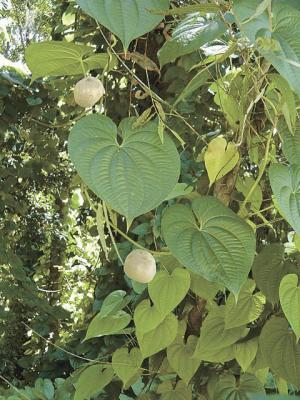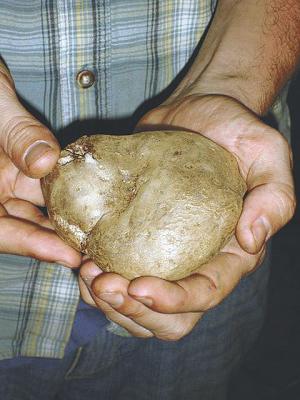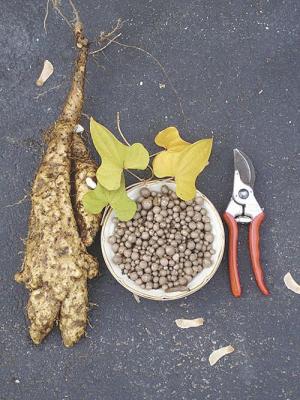"Air Potatoes" Grow Above Ground
When I first heard stories about "air potatoes" that grow above ground, they sounded too good to be true. I learned that they're members of the yam family, and that they form tubers in the ground and on their vines. They are perennial, and the above-ground tubers are supposed to be quite tasty. I wanted to try some, but the only ones I could find grow wild in Florida and are poisonous.
Then I read "Perennial Vegetables," by Eric Toensmeier. He writes about an air potato variety that yields 17,000 lbs. per acre without plowing or cultivating. I called him to find out more. He told me they were generally considered a tropical plant, not a good fit for Minnesota.
"One variety in India produces 33 tons of aerial and underground edible tubers per acre," he says. "There are varieties that could be grown from the Carolinas to California and into the Pacific Northwest."
The bad news is that seed tubers for the edible air potato are not currently available commercially in the U.S. Because of its poisonous relative, nurseries are hesitant to import it, and permits are required to grow it in several states.
"The air potato is common for subsistence farming in Mexico and Guatemala," says Toensmeier. "They haven't been commercialized into production agriculture because they produce tubers over several months."
Toensmeier grows an air potato relative called Chinese Yams that produces chickpea sized bulbs over a 6 to 8-week period. It also produces an underground tuber, but harvesting it kills the plant. Toensmeier says they are grown on trellises in Japan and yield more than 16 tons per acre. Mats are laid beneath the trellises to catch the tubers, which fall off when mature.
"I boil them for 10 minutes and eat them like new potatoes," he says. "They can be stored in a cool, dry place for 4 to 5 months."
Toensmeier is confident the edible air potato would make a good addition to U.S. gardens and small farms. Not only are they drought tolerant and have few pests, their perennial nature means reduced work load once they have been established.
"They would make a great livestock feed," he says. "You could run pigs under the vines and let them eat the tubers as they drop."
Whether for livestock feed or human food, Toensmeier is enthused about the edible air potato's potential. Like the other 100 plus edible, perennial vegetables he features in his book, the tropical yam family requires little work or outside inputs once established.
"As a general group, perennial vegetables are less work, and I like things that are less work," he says. "If there's a concern that a perennial could spread, it's best to plant it with a zone around the plant that is kept grazed or mowed to prevent spreading."
In his book, he outlines how to use perennial vegetables in your garden or yard, including propagating them from seed, tubers and cuttings. Then he profiles more than 100 of his favorites, covering how and where they will overwinter or grow as annuals. He also provides websites, plant and seed sources and other resources.
Contact: FARM SHOW Followup, Perennial Vegetables, Chelsea Green Publishing Co., P.O. Box 428, White River Junction, Vt. 05001 (ph 802 295-6300; www.chelseagreen.com).
For Chinese Yams: Tripple Brook Farm, 37 Middle Road, Southampton, Mass. 01073 (ph 413 527-4626; www.tripplebrookfarm.com).

Click here to download page story appeared in.
Click here to read entire issue
"Air Potatoes" Grow Above Ground CROPS New Techniques 34-2-35 When I first heard stories about "air potatoes" that grow above ground, they sounded too good to be true. I learned that they're members of the yam family, and that they form tubers in the ground and on their vines. They are perennial, and the above-ground tubers are supposed to be quite tasty. I wanted to try some, but the only ones I could find grow wild in Florida and are poisonous.
Then I read "Perennial Vegetables," by Eric Toensmeier. He writes about an air potato variety that yields 17,000 lbs. per acre without plowing or cultivating. I called him to find out more. He told me they were generally considered a tropical plant, not a good fit for Minnesota.
"One variety in India produces 33 tons of aerial and underground edible tubers per acre," he says. "There are varieties that could be grown from the Carolinas to California and into the Pacific Northwest."
The bad news is that seed tubers for the edible air potato are not currently available commercially in the U.S. Because of its poisonous relative, nurseries are hesitant to import it, and permits are required to grow it in several states.
"The air potato is common for subsistence farming in Mexico and Guatemala," says Toensmeier. "They haven't been commercialized into production agriculture because they produce tubers over several months."
Toensmeier grows an air potato relative called Chinese Yams that produces chickpea sized bulbs over a 6 to 8-week period. It also produces an underground tuber, but harvesting it kills the plant. Toensmeier says they are grown on trellises in Japan and yield more than 16 tons per acre. Mats are laid beneath the trellises to catch the tubers, which fall off when mature.
"I boil them for 10 minutes and eat them like new potatoes," he says. "They can be stored in a cool, dry place for 4 to 5 months."
Toensmeier is confident the edible air potato would make a good addition to U.S. gardens and small farms. Not only are they drought tolerant and have few pests, their perennial nature means reduced work load once they have been established.
"They would make a great livestock feed," he says. "You could run pigs under the vines and let them eat the tubers as they drop."
Whether for livestock feed or human food, Toensmeier is enthused about the edible air potato's potential. Like the other 100 plus edible, perennial vegetables he features in his book, the tropical yam family requires little work or outside inputs once established.
"As a general group, perennial vegetables are less work, and I like things that are less work," he says. "If there's a concern that a perennial could spread, it's best to plant it with a zone around the plant that is kept grazed or mowed to prevent spreading."
In his book, he outlines how to use perennial vegetables in your garden or yard, including propagating them from seed, tubers and cuttings. Then he profiles more than 100 of his favorites, covering how and where they will overwinter or grow as annuals. He also provides websites, plant and seed sources and other resources.
Contact: FARM SHOW Followup, Perennial Vegetables, Chelsea Green Publishing Co., P.O. Box 428, White River Junction, Vt. 05001 (ph 802 295-6300; www.chelseagreen.com).
For Chinese Yams: Tripple Brook Farm, 37 Middle Road, Southampton, Mass. 01073 (ph 413 527-4626; www.tripplebrookfarm.com).
To read the rest of this story, download this issue below or click
here to register with your account number.









